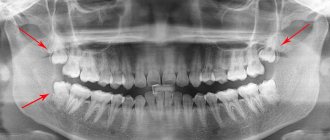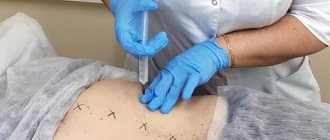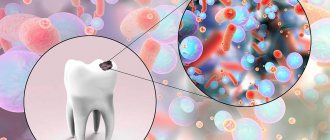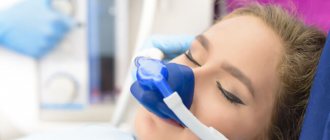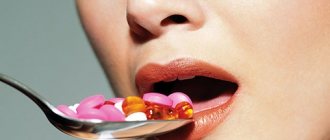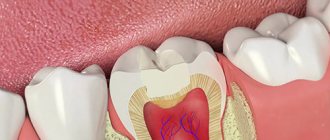Indications for tooth extraction during lactation
During the procedure, drugs are used that can penetrate into mother's milk. If it is possible to postpone the date of the operation, then extirpation is carried out after the child is transferred to artificial nutrition. A dental unit is removed urgently during a purulent inflammatory process, as it contributes to the spread of infection throughout the body.
In what cases is surgery necessary:
- suppuration of a cyst, abscess, periostitis;
- unsteadiness due to periodontitis, periodontal disease of the third, fourth degree;
- odontogenic osteomyelitis, sinusitis, phlegmon;
- tooth root fracture;
- pulpitis, which cannot be cured due to the complexity of the canals;
- impacted figure eight, complicated growth of the third molar, pressure on neighboring teeth;
- deep caries that affected the root.
Unscheduled extraction is also performed in cases of severe, persistent pain.
The procedure has contraindications, including acute respiratory infections, chronic diseases in the acute stage, oral infections, sinusitis, severe pathologies of the liver, kidneys, heart, blood vessels, leukemia, bleeding disorders, and mental disorders.
Are there any specifics to removing wisdom teeth?
Of course, there are some peculiarities when removing wisdom teeth. The doctor’s task is to make the removal process as accurate as possible, as atraumatic as possible - in principle, like the rest of the teeth. But in the case of a wisdom tooth, there are some peculiarities of anatomy.
The peculiarities are that the figure-eight tooth is located quite far away and quite well hidden. But at the same time, using modern equipment, modern materials and having experience, you can remove wisdom teeth quickly and accurately enough without consequences or injuries.
Preparing for removal
If the tooth begins to ache, the gums are swollen, and the breath smells bad, then this may indicate severe inflammation in the dental system. At the appointment, the dentist collects an anamnesis, conducts a visual examination and sends the woman for an x-ray. It is important for a nursing mother to avoid psycho-emotional stress, so she is allowed to take sedatives in advance.
The best option for maintaining mental stability and eliminating fear is oxygen sedation with nitrous oxide (NAS). It is done in the doctor's office before the procedure. The patient inhales the gas and falls asleep. Additionally, a local anesthetic is injected into the gum.
Pain after wisdom teeth removal
How long does pain last after wisdom tooth removal?
Pain after the removal of wisdom teeth lasts differently, depending on the sensitivity of the person and how the healing proceeds in general. It hurts after removing the figure eight from several days to, maximum, 7-10 days. Naturally, all pain, all painful symptoms from wisdom tooth removal subside over time.
What should you do if the wound hurts for a long time after wisdom tooth removal?
If you experience prolonged pain after wisdom tooth removal, you should contact your doctor as soon as possible, and he will adjust his prescriptions. If any problems arise, he will solve them.
The process of tooth extraction in a nursing mother
The procedure for a woman during lactation is no different from that performed for ordinary patients.
Extirpation of a dental unit is carried out in stages:
- antiseptic treatment of mucous membranes;
- anesthesia with local antiseptics or general anesthesia;
- applying forceps and disconnecting the ligament;
- rocking or dislocation;
- extraction from the hole;
- stop bleeding.
If the third molar from below is removed, the operation becomes more complicated. In order to pull it out, the doctor cuts the gum, removes part of the bone, divides the roots into fragments and removes them separately. To prevent infection, the wound is treated with antibacterial drugs. After all manipulations, the gums are sutured with absorbable or non-absorbable suture material.
What is possible and what is not?
In modern dentistry, dental treatment during lactation is a completely safe procedure. If a woman has warned the doctor that she is breastfeeding, the specialist will definitely take this fact into account and carry out all medical procedures without any harm to the young mother or consequences for the lactation process and the child. Simple dental caries treatment, including drilling and filling teeth, is not contraindicated while breastfeeding. In this case, the procedure can be performed both with and without anesthesia. If a doctor gives an anesthetic injection to a nursing mother, he uses only harmless drugs that, once passed into breast milk, will not have a negative effect on the baby.
Tooth extraction while breastfeeding is also not prohibited. However, it is worth keeping in mind that due to the severe pain that usually appears after the procedure, a woman may experience significant long-term discomfort, which can affect the lactation process and reduce the amount of milk. The list of drugs approved for use as anesthetics during breastfeeding is very narrow, and the drugs included in it may be ineffective against severe pain that develops in the area of the extracted tooth. In addition, in some cases the procedure is accompanied by complications, and the nursing mother may need antibiotic therapy. But there is no need to worry: during lactation, it is possible to use some types of antibiotics, and there is no need to interrupt breastfeeding while taking these medications.
Very often, young mothers are interested in whether it is possible to take dental x-rays while breastfeeding, because everyone knows that x-ray radiation has a negative effect on the body. Modern medicine has long used high-tech devices with a minimal irradiation dose, so this procedure does not pose a serious danger. In addition, an X-ray of a nursing woman’s teeth is done only after she puts on a special protective apron that prevents the penetration of radioactive rays into the body. Expressing milk once after the procedure completely eliminates any harmful effects on the baby.
If caries therapy and tooth extraction during lactation are clearly permitted, then dental prosthetics using implants is not carried out for nursing mothers, since this procedure uses pins that are inserted into the gum tissue. Due to the fact that a young mother's hormonal levels change significantly during breastfeeding, there is a high probability that the foreign body will not take root. Prosthetics with crowns is more preferable in this regard.
X-ray and anesthesia during lactation
Before extirpation of a dental unit, an x-ray or computed tomography is almost always done. This is necessary to assess the structure, position and condition of the root system. To protect the patient from x-ray radiation, she is wearing a lead apron. It blocks dangerous waves, but after the procedure it is better to express the first batch of milk and pour it out.
For local anesthesia, private clinics use drugs approved during pregnancy: Ultracain, Ubistezin, Artifrin, Alfacain and similar medications. They do not contain toxic components that can cause allergies and other side effects. Primacaine has a short half-life, so feedings may not be missed.
Anesthesia is used only in extreme cases, if a complex and lengthy extraction is being performed. If general anesthesia is necessary, the child is temporarily transferred to artificial nutrition. During this period, the mother must express milk regularly to ensure milk production continues.
If antibiotic therapy is necessary after a complex removal, then breastfeeding will have to be stopped for several days. During long-term withdrawal, doctors recommend giving artificial formula not through a pacifier, but through a spoon or even a syringe without a needle. Otherwise, the baby may refuse to breastfeed, since the process of sucking milk from a bottle with a nipple is much easier.
Competent removal of wisdom teeth
How to remove a wisdom tooth in the least traumatic way?
The wisdom tooth is removed atraumatically after carefully evaluating the computed tomography scan, talking with the patient, and assessing his clinical case. The tooth is separated - divided into parts if it has any bends, slopes, or several roots. And, accordingly, with the help of elevators, luxators - special dental instruments, it is carefully and carefully dislocated.
There is no need to worry about the appearance of some blood after wisdom tooth removal. The removal is carried out under the full supervision of a doctor; the wound after tooth extraction is sutured and sutures are applied. What follows is a standard rehabilitation protocol without any surprises for the patient. The only thing is that after the removal of a wisdom tooth (wisdom teeth), swelling of the mucous membrane is possible.
Why is atraumatic tooth extraction more preferable?
With this removal, the doctor takes care of the health of the patients. So that the healing takes place as comfortably as possible, so that there are no consequences after this, so that the patient in the near future, after 7-10 days, forgets that he had his wisdom tooth removed. It is after this time that possible swelling and pain after removal are completely removed.
Recommendations for the recovery period
In order to avoid complications after surgery, you need to follow all the doctor's advice. After the procedure, the doctor applies a cotton swab to stop the bleeding. It should be held for no more than 10 minutes, otherwise the blood clot will dry out and come off along with the cotton wool. With high blood pressure, bleeding continues for a longer time, so the tampon can be kept in place for 15 - 20 minutes.
In the first days you cannot:
- overheat the body, apply warming compresses;
- engage in heavy physical labor and sports;
- lick a blood clot;
- eat hot, spicy, rough food;
- drink through a straw;
- smoke;
- touch the socket with a toothbrush and other objects.
You are allowed to eat after 3-4 hours. The issue of feeding a child should be discussed with a doctor. Local anesthetics practically do not enter the blood, and components penetrate into mother's milk in minimal quantities. If the doctor has not prescribed other medications, then you can feed the baby within a few hours.
After the anesthetic wears off, pain appears. Possible increase in body temperature. To relieve acute symptoms, you can take Paracetamol, Ibuprofen, Naproxen. You can reduce pain and swelling by using cold compresses.
Rinsing your mouth and brushing your teeth is allowed on the second day. For rinsing, pharmaceutical preparations are used: Romazulan, Chlorhexidine, Miramestin. They will prevent the development of infection and inflammation. You can rinse your mouth with an aqueous solution of baking soda and salt. To improve the healing of damaged tissue, decoctions of oak bark, chamomile, and calendula are used.
Cost of wisdom teeth removal in Moscow
The price of removing one wisdom tooth in Moscow clinics, if we talk about low-traumatic removal of both lower and upper wisdom teeth, can start from a price of 15 thousand rubles
and higher. The fact is that when removing a figure eight, the cost of bone material, which is used for small bone grafting, can be added to the price of the removal itself, since after removing a deep-lying figure eight, a void may form, which, you see, needs to be eliminated due to fears of the development of atrophy bones in this area.
But many doctors, both in Moscow and in the regions, neglect bone grafting and simply suturing the wound, thereby reducing the cost of wisdom tooth removal to 8-10 thousand. The choice of price always remains with the patient, but the patient also needs to evaluate the risks of such removal, look a little into the future and understand that saving 5-10 thousand rubles at this step may result in future problems with the 6th and 7th chewing teeth ... But this is a completely different story.
Prevention measures
Extraction of a dental unit is carried out in cases where the disease is advanced or therapeutic treatment does not have an effect. Since teeth decay faster during pregnancy, it is necessary to carry out proper oral hygiene and undergo a preventive examination by a dentist while carrying a child. If pathology is detected in the early stages, removal will not be required.
Doctors' recommendations during lactation:
- brush your teeth twice a day;
- rinse your mouth after every meal, use dental floss;
- eat well;
- limit consumption of sweet foods.
During lactation, teeth can and should be treated. Even if anesthesia is performed with lidocaine, there is no need to worry. You just need to check with your doctor for how long you should refrain from feeding. The components of the drug enter milk in minimal concentrations, so when used in small dosages they will not harm the baby’s health.
Medical research and procedures for breastfeeding mothers
During the period of breastfeeding, it can be said without exaggeration that almost every nursing mother is faced with the need to carry out certain medical procedures and diagnostic tests. And, of course, you want to be sure that these procedures will not affect either lactation or the baby.
When carrying out medical procedures, a nursing mother must verify the need for this study. You can often come across the opinion that after procedures such as fluorography, x-rays, computed tomography or magnetic resonance imaging, you should stop breastfeeding for some time (from several hours to several days). However, research shows that this is not always the case. In this article we will try to consider the possibility of conducting basic medical research on breastfeeding.
Ultrasound diagnostics does not affect breastfeeding in any way and has no restrictions for use in nursing mothers. When faced with a problem such as lactostasis, a woman often undergoes examination using ultrasound diagnostics to exclude mastitis.
A biopsy of breast tissue may be indicated for mothers if it is necessary to determine the nature of the lump in the breast. This quick, virtually painless procedure is often performed without even the use of local anesthesia and does not affect breastfeeding. [2]
Gastroscopy and colonoscopy. A nursing mother may be faced with the need to undergo diagnostic procedures such as gastroscopy or colonoscopy. These manipulations can be carried out without restrictions during breastfeeding. During gastroscopy, lidocaine is often used, but this drug is compatible with breastfeeding, in addition, it is used topically (in the form of an aerosol) and does not cause harm to a breastfeeding baby. Some patients prefer to have gastroscopy and colonoscopy performed under general anesthesia, but even in this option, a nursing mother will be able to resume breastfeeding almost immediately after the cessation of general anesthesia (check with your anesthesiologist for the name of the drug for general anesthesia, and we will tell you the exact period time after which it will be safe to breastfeed again).
Mammography can be performed during lactation, but the result of mammography will be quite difficult to interpret and evaluate due to natural changes in breast tissue during lactation. During breastfeeding, a mammogram can be useful in determining the size and location of known tumors and lumps, but may not always detect changes in the soft tissue of the lactating gland. If a mammogram is indicated for a nursing mother, it is best to consult a doctor who has experience in performing this procedure during lactation. It also makes sense to take your baby with you and feed him immediately before the test to reduce the amount of milk in the ducts and make the mammogram more readable. [2]
Fluorography during breastfeeding can also be done, but it is advisable to carry it out only when indicated. If possible, it is better to postpone fluorography for preventive purposes until the child is finished feeding. As modern research shows, performing FLG is not a reason to terminate or suspend breastfeeding.
X-ray with guards . As modern research shows, there is no reason why a mother should temporarily wean her baby because of an x-ray. Breast milk is not affected by x-rays and the mother can feed the baby immediately after the examination. [2]
CT and MRI without contrast. Both of these procedures do not affect breast milk or breastfeeding in general. The electromagnetic field and radio waves used in this diagnostic method do not cause changes in the composition of milk. [8]
X-ray with contrast agent, computed tomography and magnetic resonance imaging. Many radiologists advise a nursing mother to stop feeding for a certain period of time, for example, after an X-ray of the kidneys, a lymphangiogram, or after an X-ray of the gallbladder. This is due to the fact that these types of studies are carried out with contrast agents, which are used to enhance the visualization of various organs and tissues.
Two types of radiocontrast agents are commonly used: one group contains high concentrations of iodine; the other group contains gadolinium ions. A group of iodinated radiocontrast agents are used for computed axial tomography (CT), while gadolinium products are used for magnetic resonance imaging (MRI).
In general, it is recommended to refrain from using iodine-containing products while breastfeeding. But in the case of radiocontrast agents, the iodine molecule is covalently bound to the base and thus the number of free iodine molecules is minimal, so they are not considered to be a risk factor for a breastfeeding baby. In addition, the plasma half-life of these substances is very short (less than 1 hour for most), and their bioavailability through milk is virtually zero. Although manufacturers of x-ray materials always advise that you stop feeding for about 24 hours after these procedures, this is not necessary. [1,2,4]
For example, barium, used in diagnostic studies of the digestive system, is not absorbed by the mother or child and does not affect breastfeeding [1,2]
The famous pediatrician Dr. Newman writes about this: “...most radiologists admit that there is no need for this, because the amount of iodine penetrating into the milk will be negligible and will not affect the child. Despite this, they still prohibit feeding after these procedures because it is recommended by the manufacturer and none of them want to take the risk. The fact that many of these tests are also done on children with the same contrast agents somehow does not make them think about what exactly they are worried about. The answer, of course, is that we are not worried about mothers or children, but about being held accountable despite the fact that most likely nothing will happen...” [3] Magnetic resonance imaging is also not reason to stop feeding for 24 hours. The contrast material used for MRI is gadopentetic acid, a compound with a very short half-life (less than an hour) that is completely eliminated from the mother's body over the next 6 hours [3]. It has also been reported that the level of gadopentetic acid in breast milk is very low. Only 0.23 percent of the maternal dose was excreted in milk more than 24 hours after the study. Additionally, the oral bioavailability of gadolinium products is approximately 0.8 percent [6]. Thus, there is no reason to stop breastfeeding after an MRI, despite the fact that the manufacturers of the substances recommend a break of 24 hours [3]. Dr. Thomas Hale also writes that no side effects have been reported in children whose mothers took radiocontrast agents while breastfeeding [1].
Use of radioisotopes . Radioactive substances are commonly used to diagnose or treat thyroid disease, heart disease, tumors, and other problems. In general, the dose required for a diagnostic study will be less than the usual therapeutic dose. When radioactive substances are used, in many cases the child must be weaned, at least for a while, because Radioactive substances tend to accumulate in milk and reach the baby. Weaning time depends on the type of radioactive substance and dose (see the table at the bottom of the page for more information).
Breastfeeding mothers should discuss with their doctor all possible diagnostic alternatives (blood tests, ultrasound, CT, MRI) to be absolutely sure of the need to use radioactive substances and discuss with the doctor the possibility of using a substance with the shortest elimination period. If the mother and her doctor come to the conclusion that a diagnosis with a radioactive isotope is necessary, then the nursing mother can express the required amount of milk in advance to feed the baby during temporary weaning.
Typically, radioisotopes used as diagnostic agents have fairly short half-lives and do not pose a major problem for breastfeeding. Breastfeeding moms can simply pump and empty their milk for 12 to 24 hours before resuming breastfeeding. [4]
However, when using Iodine-131, Gallium-67, or Thallium-201, longer periods of abstinence from breastfeeding may be necessary, which will interfere with breastfeeding.
The most dangerous radioisotope listed is Iodine-131. It accumulates in human milk and can potentially have a very negative effect on the baby's thyroid gland, and can also significantly increase the baby's risk of thyroid carcinoma if the baby receives this substance through mother's milk. Women who require treatment with Iodine-131 should stop breastfeeding for several weeks before using the substance, because Research shows that if breast tissue is active (due to breastfeeding or pumping), about 40% of the radiation dose will be delivered to the breast, increasing the mother's risk of developing breast cancer [5]. Weaning for a few weeks allows the gland tissues to go through the stage of involution and return to their pre-pregnancy state [2].
Dr. Newman believes that studies using radioactive isotopes should be carried out for breastfeeding women when the importance of the examination outweighs the risk of radiation to the child. “The most commonly used radioactive component for such studies is teknetium-99,” he writes, “it is used to examine the lungs, bones, brain, etc. Its half-life is 6 hours, so 98% of it will be eliminated from the mother body in 30 hours. Does this mean that the mother should stop feeding for 30 hours? Many will say that this will be the best solution. However, I think it's too long. A child may receive some radiation exposure; we rarely hesitate before performing a chest x-ray on a child, for example. Of course, it is better to avoid radiation that you can do without, but there is still a point where the risk is infinitesimal. If the mother waits 12 hours (2 half-lives), 75% of the radiation will have already been eliminated from her body. Each mother, together with her healthcare provider, must decide on a case-by-case basis whether the risk of breastfeeding after exposure to radioactive substances outweighs the risk of formula feeding." [3]
The most comprehensive source of information on the compatibility of radioisotopes and breastfeeding is published by the Nuclear Regulatory Commission (NRC). Breastfeeding mothers who need to use radioisotopes due to their health conditions can use this information [4].
Example of typical recommendations for the compatibility of radioisotopes and breastfeeding [7]
| Radioactive drugs | Example of typical weaning recommendations |
| I-131 NaI | Complete weaning (for a given child) |
| I-123 NaI | Weaning is not necessary |
| I-123 OIH | Weaning is not necessary |
| I-123 mIBG | 24 hours for 370 mBq (10 mCi) |
| I-125 OIH | Weaning is not necessary |
| I-131 OIH | Weaning is not necessary |
| Tc-99m DTPA | Weaning is not necessary |
| Tc-99m MAA | 12.6 hours for 150 mBq (4 mCi) |
| Tc-99m Pertechnetate | 24 hours for 1,100 mBq (30 mCi), 12 hours for 440 mBq (12 mCi) |
| Tc-99m DISIDA | Weaning is not necessary |
| Tc-99m Glucoheptonate | Weaning is not necessary |
| Tc-99m HAM | Weaning is not necessary |
| Tc-99m MIBI | Weaning is not necessary |
| Tc-99m MDP | Weaning is not necessary |
| Tc-99m PYP | Weaning is not necessary |
| Tc-99m Red Blood Cell In Vivo Labeling | 6 hours for 740 mBq (20 mCi) |
| Tc-99m Red Blood Cell In Vitro Labeling | Weaning is not necessary |
| Tc-99m Sulfur Colloid | 6 hours for 440 mBq (12 mCi) |
| Tc-99m DTPA Aerosol | Weaning is not necessary |
| Tc-99m MAG3 | Weaning is not necessary |
| Tc-99m White Blood Cells | 24 hours for 1,100 mBq (5 mCi), 12 hours for 440 mBq (2 mCi) |
| GA-67 Citrate | 1 month for 150 mBq (4 mCi), 2 weeks for 50 mBq (1.3 mCi), 1 week for 7 mBq (0.2 mCi) |
| Cr-51 EDTA | Weaning is not necessary |
| In-111 White Blood Cells | 1 week for 20 mBq (0.5 mCi) |
| Tl-201 Chloride | 2 weeks for 110 mBq (3 mCi) |
The duration of breastfeeding interruption is chosen to reduce the maximum dose to the newborn infant to less than 1 millisievert (0.1 rem), although the regulatory limit is 5 millisieverts (0.5 rem). The actual doses that most infants would receive would be less than 1 millisievert (0.1 rem). Of course, the doctor can use these recommendations at his own discretion, increasing or decreasing the required duration of interruption of breastfeeding. [7].
In this article, we told you whether it is possible to do fluorography, x-rays, MRI, ultrasound and other procedures while breastfeeding. You may be interested in our other articles about the health of nursing mothers.
Call a consultant Do you have any questions? +7 (812) 956-3-954
Literature:
- Hale T., Medications and Mother's Milk, 10th edition, Amarillo, TX 2002.
- Mohrbacher N., Stock J., La Leche League International, The Breastfeeding Answer Book, Third Revised Edition, 2008
- Newman J., Pitman T., The Ultimate Breastfeeding Book of Answers (Revised and Updated), NY, Three Rivers Press, 2006
- Riordan J., Auerbach K., Breastfeeding and Human Lactation, Jones and Bartlett, Boston, 1999
- Robinson P. et al , Iodine-131 in breast milk following therapy or thyroid carcinoma. J Nucl Med 1994; 35, p:1797-1801.
- Rofsky N., Weinreb J., Litt A., Quantitative analysis of gadopentetate dimeglumine excreted in breast milk. J Magn Reson Imaging 3 p:131–132, 1993.
- US Nuclear Regulatory Commission . Nuclear Regulatory Commission Guideline 8.39. Washington, DC, April 1997
- E-lacatancia. Marina Alta Hospital https://e-lactancia.org/sinonimo/935
Alena Lukyanchuk, psychologist, lactation consultant
Alena Korotkova, clinical psychologist, lactation consultant
Is it possible to use anesthesia during breastfeeding?
When treating teeth, you should not refuse anesthesia just because the mother is breastfeeding. There are modern drugs with a short-term effect - ultracaine and lidocaine. They are safe for the child and are eliminated from the body after a few hours. If you are concerned about the quality of milk, it is recommended to feed your baby before visiting the doctor, and after treatment to express your breasts.
Sometimes at a doctor’s appointment it turns out that the situation is much more complicated than it seemed. In this case, serious treatment and medications that are incompatible with lactation will be required. What to do? The best option would be formula feeding for this period. To preserve the mother's milk, it is recommended to express regularly so that lactation does not stop. However, modern medications are in most cases compatible with breastfeeding.

